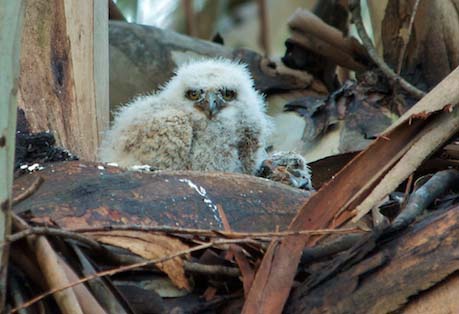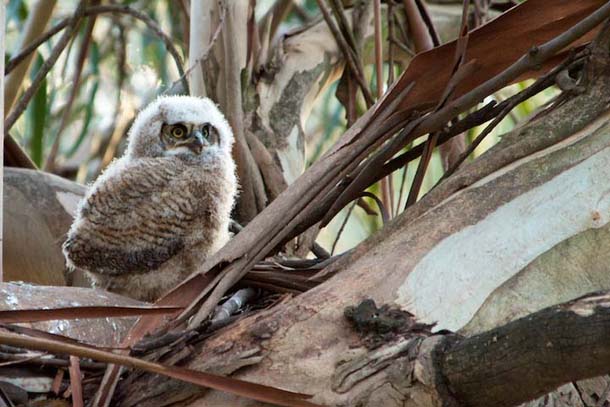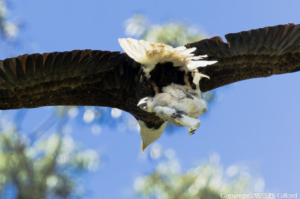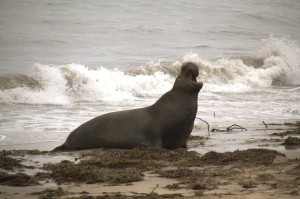One evening, as I rounded the bend to the great horned owl nest in Claremont Canyon, I noticed another photographer already set up in my preferred spot. The owl parents and their owlet had become an East Bay sensation ever since the mama began dive-bombing dogs in early March. But up until then, I had been lucky and had not encountered the owl paparazzi I had feared would be drawn to the much-publicized nest.
The other photographer was welcoming and made space for me to join her on the side of the trail. We watched the sleepy owlet, along with many others who stopped to watch. As the sun began to set, the owlet began to yawn, stretch and preen — great moments to try to capture in an image. The other photographer turned on her external flash and began snapping away.
As a wildlife photographer, I couldn’t help but to try to rein her in. I explained that a bright flash might harm the owlet’s developing eyes, and just wasn’t respectful of its still-fragile place in the world. The photographer argued that the flash was so fast it probably would do no harm; plus, it would be hard to capture sharp images otherwise.
I went home and thought more about the encounter. Some research revealed that although there was no definitive MO on flash photography and owls, many experts recommend a policy of “Do no harm.” Depending on the source, that translates to not using the flash, using it sparingly, or only during the day. In its ethics code, the American Birding Association states: “Use artificial light sparingly for filming or photography, especially for close-ups.”
During my field expeditions, I often worry about the impact I have on the birds and mammals that I watch and photograph. I absolutely love finding an interesting animal and having the opportunity to observe its behavior. But I try hard to respect the animal and minimize my impact on its stress level, hunting success, and general way of life.
This great horned owl nest presented a unique challenge to quiet observation, as the nest is located in a large eucalyptus tree directly above a heavily trafficked trail. There is no natural cover to fade into. And there is a fairly constant stream of hikers, runners, and dog walkers passing right underneath. In addition to all the normal users of this trail, many owl lovers (like me) have been visiting, tipped off by online articles and photos, or the local birding community.
Some I have talked to think the owls chose this spot because it is so trafficked by people and, thus, perhaps more protected from natural predators who may be scared off by the human activity. Others note that the last time great horned owls were known to nest here, in 2008, the chicks seemed to fledge too early.
This year, two owl chicks hatched at the end of March, but unfortunately, only one of the chicks has survived. It is not clear what happened to the second owlet, although it seemed to perish in the nest during a week with multiple nights of rainy, windy storms.
On the days that I have visited, I have encountered many other people who are delighted by the close-up views. Birders come with their binoculars, mothers with their young children, runners and neighbors who walk these trails regularly, and many others. And there are, of course, many people taking photos with a variety of cameras from cell phones to professional wildlife rigs complete with flash.

-
Life and death in the owl’s nest. The surviving owl sits next to its dead sibling. Photo by Jen Joynt.
It is nearly impossible to know what impact our presence is having on the owlet or its parents. I have watched the mother swoop down on a dog (even dogs on leash). I have seen the owlet roused from sleep and open its eyes wide when a passerby, in search of a direct view of the nest, climbed up and then crashed loudly and slid down the hillside.
Then again, I have also observed the owlet sleeping in the nest while a dozen people watched intently and discussed the young owl’s progress.
Last time I was there, the owlet was gone. It had been practicing flying in recent weeks, hopping around and flapping its wings. I am hopeful the young owl took flight and is now hiding peacefully deep in the eucalyptus forest, perhaps near its mother and away from the all the staring eyes.

.jpg)






